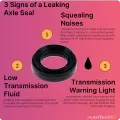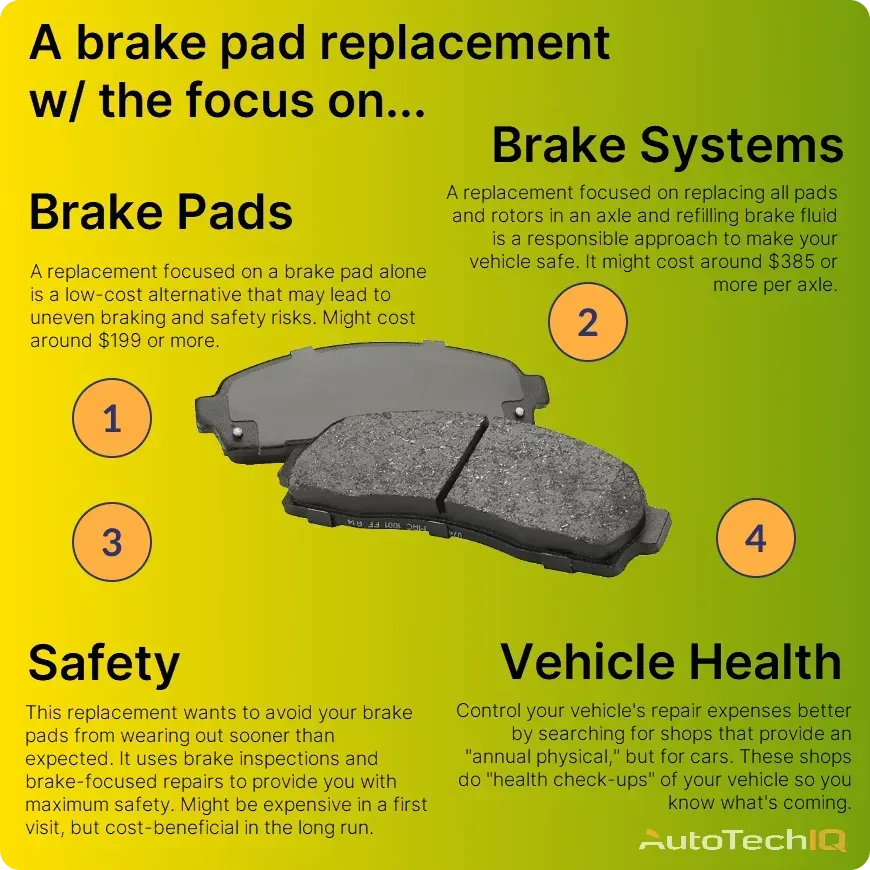
The brake pad replacement cost for non-luxury vehicle brands like Chevrolet, Toyota, and Ford is typically between $100 to $350 per axle:
-
Shops typically charge to replace per axle, not for a single wheel.
-
Shops commonly quote to replace brake pads + rotors
-
The $100 - $350 range isn’t realistic if you want long-lasting brake fixes.
Why do shops do per-axle brake pad replacements?
Most shops won’t replace brake pads for a single wheel but for an entire axle to avoid uneven braking. The friction of the brake pad material and rotor metallic surface has to be equal. Uneven pads cause these safety issues:
Reduced stopping power: Uneven pads mean that more pressure needs to be applied to the brake pedal to slow the car down evenly, which increases stopping distances.
Pulling sensation: When one brake pad wears down more than the other, the car can pull to one side during braking.
Increased risk of brake damage: Uneven wear stresses the brake system, leading to warping or cracking of the brake rotors.
The brake pad and rotors cost
The cost of brake pad replacement typically involves some work done on the rotors, too.
This is because, over time, the rotors can become grooved, warped, or uneven, which makes your car shaky and worse at braking. Resurfacing smooths out any damage or wear, so the new pads can fit nicely around them and improve your brake response. If the rotors are too damaged, replacing them as a whole is the best bet for safety.
Can I replace the brake pads and not the rotors?
In theory, yes, but it’s not safe to replace brake pads without knowing the condition of the brake rotors. Remember, when brake pads wear, rotors wear too. Here's a breakdown:
Replacing only the pads is possible (yet unlikely) if:
-
Rotors are within spec: Their thickness is above the minimum specified by your vehicle's manufacturer. You can usually find this information in your car's repair manual.
-
Rotors have no deep grooves or warping: Deep grooves or warping can make the brakes grind, reduce braking performance, and damage the new pads.
Here's why you might want to consider replacing the rotors anyway:
Uneven wear: Old rotors may have a wear pattern that doesn't match the new brake pads perfectly. This might cause noise and vibration in the braking system.

-
Reduced lifespan: A brake rotor replacement might preserve the new pads better.
-
Future replacement: If your rotors are close to needing replacement anyway, it might be more cost-effective to do them both at once.
For context, replacing brake pads and rotors is typically $160 to $500 per axle.
Brake pad replacement cost: What affects the final price?
A brake pad replacement has different factors changing its final cost. Consider two types of expenses: common replacement costs and long-lasting fix costs (if you want to permanently fix your brake pad issue).
Common replacement costs
-
The brake pad material: Prices vary depending on the material. For common car brands, ceramic brake pads typically cost $87, ultra-premium ceramic brake pads $160, standard organic brake pads $58, etc., metallic brake pads and semi-metallic brake pads are also within that range.
-
The labor rate: Labor rates change between professionals (ASE technicians charge more than rookie mechanics), and regional wage differences.
-
The shop’s neighborhood/area: Areas will determine the replacement cost. For example, Santa Barbara in California has different prices than Albuquerque, in New Mexico; this could be due to lease rates, cost of living, etc.
-
The vehicle type: European brands like Mercedes, BMW, Audi, etc., have different prices for brake pad replacement. For example, an Audi brake pad replacement can typically start at $600 and go above $1000.
How does the brake pad replacement return my vehicle to safety standards?
If your brake pads are worn because of common brake wear, meaning nothing else was forcefully wearing them out, a brake pad replacement returns the vehicle to safety standards.
However, you can’t be sure if you reach safety standards without at least a brake inspection.
What exactly is a brake inspection?
The brake inspection is a paid “detective work” where mechanics note and record everything that’s not working as expected in your brake system.
-
Mechanics inspect the vehicle, noting every concern affecting the brake performance/safety and searching for any issue causing extra wear on the brake pads.
-
They show you their observations and propose suggested repairs to get the brake system working 100%.
-
They do a quote for the suggested repairs.
The proposed repair after the inspection might be just a brake pad replacement if nothing else is faulty. However, if the main problem is not just normal brake pad wear and involves other systems, the suggested quote can increase.
Here are the routes you can go based on your options.
-
Brake pad replacement: This means you want the brake pad replacement and nothing else, so you’ll probably only pay the common replacement costs. The downside is that you might not discover what caused the pads to go bad in the first place. Assume there’s a problem somewhere else in your car that’s forcing the brake pads to wear down faster. In this situation, getting new pads won’t solve the issue, it might just make you return to the shop soon to replace the pads again.
-
Long-lasting fix: This means you want to permanently fix your vehicle and understand what might be wrong with it. So, you want to investigate if there’s an issue causing your brake pads to wear down faster than expected, and if there is, you want to eliminate it. You’re willing to spend more money to cover extra processes that ensure your car runs safely and reliably.
Why have a long-lasting fix? The short answer is to save money and stress while ensuring the vehicle is safe for the next thousands of miles. A long-lasting fix provides maximum safety with the goal of not having you return to the shop for a really long time.
Costs and services of a long-lasting brake fix
A long-lasting fix has factors changing the final price. Here’s what you can expect:
-
Brake inspection: A brake inspection usually costs below $200. This is an investigation of your brake system involving the labor of service advisors and mechanics to discover issues/due repairs.
-
Component replacements: The inspection indicates other worn components in the brake system that require replacement. This depends on the specific condition of the vehicle.
-
Other systems repairs: The shop might find other malfunctioning systems requiring parts replacements and/or computer reprogramming, affecting the cost range. For example, replacing a leaking axle seal from the suspension system that excessively wears the brake pads can add more costs to the final quote.
For context, a full brake replacement job on an axle might cost between $400 and $1200, including pad, caliper, rotor, and brake fluid replacement.
How to get transparent long-lasting repairs
If you want to:
-
Investigate your worn brake pads: Discover if something is wearing them out excessively and damaging your brake system.
-
Fix the whole problem: If something damages the brake pads and brake system, fix it so it doesn’t return anytime soon.
-
Get maximum safety: Drive with peace of mind, knowing your brakes are 100% safe and you’re far from visiting the shop because of brakes again.
Then, relying on online estimates is MISLEADING. Online estimates only price the brake pad replacement, and won’t consider whether you want a long-lasting solution. The solution for your brake pads wearing out excessively is specific to your vehicle.
The best way to get a precise estimate is to seek shops with a certified “transparency process” to perform a brake inspection for you. Their transparency relies on documenting everything about your brake system condition and clarifying their findings with edited images and videos of your car.
Let’s see an example of a transparency-focused brake repair about a worn brake pad.
A transparent, safety-focused brake pad replacement example
A full brake inspection’s main goal is to discover the brake system’s condition, investigate chronic issues, and check if all braking components work as expected.
For instance, if a shop is requested to do a brake inspection due to worn brake pads, the mechanics examine the pads and review the entire brake system.
They’ll check every brake component for signs of wear, tear, or leaks to find if something prevents the brakes from operating as expected. The inspection may reveal the need to replace various components and identify anything causing extra wear on the brake pads.

For example, if mechanics find a faulty axle seal leaking onto the brake pads, making them sticky and leading to premature wear, they mention it in the inspection.
In this case, the mechanic put the “Immediate Attention” tag on the brake pads and rear axle seal since they involve safety. This means the two main priorities are to fix the seal to eliminate the leaks and replace the axle’s brake pads.
The final quote also suggests replacing naturally worn brake components they’ve spotted during the inspection.
Why this level of transparency?
These businesses want to help you make the right decisions by providing education about your car so you can budget for the necessary repairs at current and future visits. It’s cost-beneficial for you and the auto repair facility.
Why is it cost-beneficial for you?
They won’t simply fix your problem. They’ll make sure it doesn’t return for thousands of miles.
Why is it cost-beneficial for them?
Most of these shops want to keep you as a customer for life. They want people to trust and recommend them, strengthening their bond with the community and growing their businesses.
The “find shops providing a DVI” method
Fortunately, you can have that level of transparency beyond the brake inspection. The so-called DVI method leads you to shops offering a transparent vehicle health check-up.
This method focuses on two things:
-
Does the shop have a modern DVI?
-
Does the shop have certifications?
What’s a DVI? As mentioned earlier, It’s like an annual physical visit to the doctor to assess the body’s vital signs, but for a car instead; most auto repair shops don’t charge to do it. The DVI regularly creates your vehicle’s “state of health,” explaining its overall condition.
The mechanic uses the DVI results to inform the conditions of your vehicle’s systems and the recommendations to get it running reliably. If they find issues, they’ll list them in order of priority.
Let’s see an example of how the DVI can help with a brake pad replacement:
A DVI helps with a brake pad replacement
The DVI starts with the mechanic checking vehicle systems (suspension, brakes, steering, etc.) for signs of wear/tear/leaks. They’ll document everything through notes, videos, and pictures.
If they spot brake pad issues, they’ll edit images and videos to indicate points of concern (damages, leaks, components’ locations, etc.) surrounding the brake pads. They’ll highlight their findings using arrows, circles, and text.
In the image below, the mechanic found that the brake pad was wearing out faster due to an axle seal leak.

A document with the vehicle’s health status is sent to the customer, with room for questions through online/phone or over-the-counter communication. The customer sees what repair priorities their vehicle has and what should be checked in the near future.
In this case, they’ll see a brake pad and axle seal replacement priority. The focus is to educate and help the customer make informed decisions about their car.
Certifications
Today’s auto industry has certifications for customer-educational and transparent businesses. For example, the AutoTechIQ certification makes shops that fit into the DVI method stand out on your local map. So you can find the one closest to you.
The shops with an AutoTechIQ certification typically feature 100+ excellent Google reviews! You can quickly find this certification on a shop’s website or using AutoTechIQ’s “Find a shop” map.
FAQ on Brake Pad Replacement Cost
How long do brake pads last?
Brake pads typically last between 30,000 to 70,000 miles, but their lifespan depends on several factors, including driving habits, road conditions, and the type of brake pads used. For example, aggressive braking or frequent stop-and-go driving, such as in city traffic, can wear brake pads down faster. Conversely, highway driving with minimal braking can help them last longer. The type of brake pads also plays a role: organic pads tend to wear out more quickly, while ceramic and semi-metallic pads generally last longer. Regular inspections are important because worn brake pads can lead to reduced stopping power and damage to the rotors. Signs that brake pads may need replacement include squealing noises, reduced braking performance, or a brake warning light on the dashboard.
Should I replace all four brake pads at once?
You don’t necessarily need to replace all four brake pads at once, but it’s important to replace them in pairs—either the front or rear brakes together. The front brakes typically wear out faster since they handle most of the braking force, so they often need replacement sooner. Replacing only one brake pad on a single axle (left or right) can cause uneven braking, leading to reduced performance and potentially dangerous handling issues.
If all four pads are significantly worn or close to needing replacement, it can be cost-effective and efficient to replace them all at once. Additionally, when replacing brake pads, it’s a good idea to inspect the rotors, calipers, and other components to ensure the entire braking system remains in good condition.
Do I need to replace both brake pads and discs?
You don’t always need to replace both brake pads and discs at the same time; it depends on the condition of each. Brake pads typically wear out faster than discs, so they might need replacement more frequently. However, if the brake discs are warped, excessively worn, or below the manufacturer’s recommended thickness, they should be replaced along with the pads. Continuing to use worn discs can reduce braking performance and cause uneven wear on the new pads.
It’s generally recommended to replace the discs if they have deep grooves, visible damage, or if the vehicle vibrates when braking, which indicates rotor issues. Some mechanics also advise replacing both components together for optimal performance and to avoid mismatched wear, but this isn’t always necessary if the discs are still in good condition.
How much does it cost to replace brake pads?
The cost of replacing brake pads typically ranges from $100 to $300 per axle, depending on the type of car, the quality of the pads, and the labor charges. Luxury or performance vehicles can have higher costs due to specialized parts. If you're replacing both front and rear pads, the cost may double.
Why is the cost of brake pad replacement so high?
The cost includes both parts and labor. Brake pads themselves can vary in price depending on their material (organic, semi-metallic, or ceramic). Labor charges depend on the mechanic's hourly rate and the complexity of your vehicle's brake system. Additionally, shops may recommend resurfacing or replacing the rotors, which adds to the overall cost.
Do I need to replace the rotors when changing the brake pads?
While not always necessary, it’s common practice to either resurface or replace the rotors when changing brake pads. Over time, rotors can become worn down, grooved, or warped, which can affect braking performance. Resurfacing smooths the surface, ensuring the new brake pads perform at their best. If the rotors are too damaged, replacing them can be an additional cost, typically $150-$300 per rotor.
How long do brake pads last before I need to replace them?
Brake pads typically last between 30,000 to 70,000 miles, depending on driving style, road conditions, and the type of brake pads used. Frequent city driving with lots of stopping can wear pads out faster, while highway driving may extend their lifespan.
Can I replace the brake pads myself to save money?
If you have the right tools and experience, you can replace the brake pads yourself. Doing so could save on labor costs, but if you're unsure or inexperienced, it’s best to have a professional handle the job to ensure it's done safely and correctly.
Are there cheaper alternatives to replacing brake pads?
While some may try to use cheap brake pads to lower costs, it’s important to consider the quality of the parts. Cheap pads can wear out quicker, leading to more frequent replacements and possibly damaging the rotors. Investing in high-quality pads can save you money in the long run.
Does my car’s make and model change the brake pad replacement cost?
Yes, the make and model of your vehicle can significantly affect the cost. Luxury, performance, and certain foreign cars may require more expensive parts and specialized labor, leading to a higher overall cost. It's always a good idea to get a few quotes before deciding on where to get the work done.
How can I tell if I need new brake pads?
If you hear a squeaking or grinding noise when braking, feel vibrations or notice that the brakes aren’t responding as effectively, it’s time to get your brake pads checked. Most vehicles also have a wear indicator that produces a noise when the pads are low.
Do I need to replace the brake pads immediately after they wear down?
Yes, it’s important to replace worn-out brake pads as soon as possible. If the pads are too thin, you might damage the rotors and decrease braking performance, leading to danger. Replacing pads early will save you money in the long run and keep your car safe.
How much are other repairs costing?
Other news
-
Car is Squealing When Driving
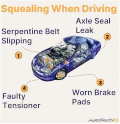
-
What is Preventative Maintenance and What Are The Benefits of it?

-
JobViewIQ - DVI Process Training - Part of the Auto Care Alliance Benefits

-
7 Signs of AC Pulley Issues
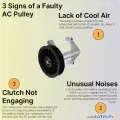
-
7 Signs of Clogged AC Components
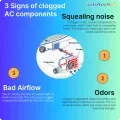
-
How Much Does a Transmission Fluid Change Cost?
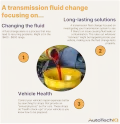
-
7 Signs of a Leaking Axle Seal
